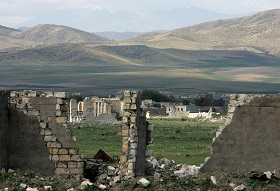The recurring escalation of the Nagorno-Karabakh conflict has become a negative trend in recent years. Clashes occur every several months, going beyond the usual war between snipers and taking the form of full-scale shelling of parties’ positions with grenade launchers, mortars and heavy machine guns as well as incursions by raiding forces.
The recurring escalation of the Nagorno-Karabakh conflict has become a negative trend in recent years. Clashes occur every several months, going beyond the usual war between snipers and taking the form of full-scale shelling of parties’ positions with grenade launchers, mortars and heavy machine guns as well as incursions by raiding forces.
The periods of August 2014, the end of autumn 2014 (when an Armenian helicopter was shot down on November 12) and January 2015 saw particularly dangerous confrontations. Another escalation began in March 2015 and has been ongoing with varying degrees of intensity until now. For example, Karabakh’s capital Stepanakert accused Baku of 1200 shooting attacks during the week from March 22 to 28; of 700 – from March 29 to April 4; of 900 – from April 5 to 11; of 800 – from April 12 to 18; and of 1200 – from April 19 to 25.
In turn, Azerbaijan has repeatedly accused the Armenian side of upwards of 57, 50, 36, and 30 shooting attacks per day. On March 26, 2015, a soldier in the armed forces of Azerbaijan was killed in the Tartar District; on March 29 and on April 6, two Armenian servicemen were killed along the contact line; a resident of Zeyva village in Goranboy region of Azerbaijan was killed in a mine explosion on April 15; an Azerbaijani soldier was killed on April 16. Several people on both sides (reports on the number of dead and wounded vary) died during clashes on the night of March 6, on March 19, and on the night of April 21. Obviously, the situation is not stabilizing, and tension along the contact line remains at a consistently high level, if not mounting.
At the same time, it is indicative that the armed stand-off is taking place not only along the contact line around Nagorno-Karabakh, but on the border between Armenia and Azerbaijan too. As a result, the village of Choratan of Armenia’s Tavush province was shelled twice on April 6, 2015, and on April 5, 2015, Armenian forces fired from the village of Paravakar in the same province at Azerbaijani positions in the village of Kohnegyshlag in Azerbaijan’s Agstafa region. It is clear that such attacks are neither isolated nor random. Given that there are no international observers in the conflict zone, identifying the initiator of these incidents with any degree of certainty appears virtually impossible. But any unbiased observer has little doubt that maintaining a constant tension at the line of contact plays into the hands of Azerbaijan, which places a stake on wearing down Armenia through a kind of psychological warfare.
Why is the escalation of the conflict observed not only over Nagorno-Karabakh, but also in the northern part of the Armenian-Azerbaijani border (Tavush province)? Most likely, Baku is trying to test the strength of Armenia’s positions, its self-confidence and the confidence in its allies (namely Russia). According to most experts, in exchange for Yerevan’s decision to join the Customs and the Eurasian Economic Union, made in September 2013, Russia confirmed the provision of security guarantees to Armenia. The existing legal framework, including membership in the Collective Security Treaty Organization and the Treaty of Friendship, Cooperation and Mutual Assistance between the two countries, allows Yerevan to rely on Moscow’s help in the case of Azerbaijan's aggression against Armenia.
The question is whether these guarantees apply to Nagorno-Karabakh as well, including whether Russia will intervene in the event of war on the territory of this republic alone. At this juncture, the case in question concerns the aggressive actions of Baku not against Stepanakert, but against the territory of Armenia. Therefore, the lack of a clearly defined position by Moscow in relation to cross-border incidents has fully met the expectations of the Azerbaijani leadership.
Baku has pursued and continues to pursue quite understandable and logical goals. First, it wants to increase doubts among the leadership and political elite of Armenia over Russia's reliability as a military and political ally. Second, it wants to convince other countries in the region and the international community as a whole that Russia’s security guarantees are not reliable. Third, it wants to instill in the minds of Azerbaijan’s leadership, its political elite and the society that the solution to the Karabakh problem using a strong arm is possible and quite practical. In other words, it could be well regarded as some kind of collective psychotherapy.
With all of this going on, there is little doubt that at this stage Azerbaijan will not settle the problem of Nagorno-Karabakh by force. At the same time, a rather rapid deterioration of the economic situation in Azerbaijan, the devaluation of the manta and lowered standard of living are ugly symptoms that could make maintaining the image of Armenia as an external enemy a necessity and could at any time encourage the country's leadership to embark on a military adventure. One can only hope that official Baku will not lack rationale to refrain from it.
Given that Russia is interested in preventing full-scale military confrontation, it appears necessary to confirm its security guarantees to Yerevan on a regular basis and to emphasize the inadmissibility of a military solution to the Nagorno-Karabakh conflict. It seems that sometimes this happens with a delay.





